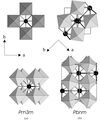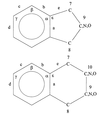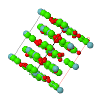issue contents
June 2004 issue

Cover illustration: Crystal packing diagram of 1,4-benzoquinone with Hirshfeld surfaces. The translucent gray surfaces illustrate the nature of these novel surfaces and how they envelop each molecule and reflect the presence of neighbouring molecules. Colours mapped on the central surface represent the distance from the surface to the nearest nucleus in an adjacent molecule: red (shortest), through green, to blue (longest) (McKinnon, Spackman & Mitchell, Acta Cryst. B, in preparation).
research papers
Download citation


Download citation


A perchlorate salt of the hydroxo-bridged cis-diammineplatinum(II) dimer has been shown to possess a bent structure in which two Pt coordination planes within the dinuclear cation are tilted at an angle of 151.7 (1)° to one another.
In this contribution we use the bond-valence concept to develop a model that predicts the relative compressibilities of the cation sites in oxide perovskites. This model, based only upon room-pressure bond lengths and bond-valence parameters, correctly predicts the structural behaviour and some physical properties of the oxide perovskites that have been measured at high pressure.
Download citation


Download citation


The crystal structure of a new binary intermetallic compound Mg1 + xIr1 − x (x = 0–0.054) with 25 atoms in the asymmetric unit was independently characterized by the high-resolution synchrotron powder and single-crystal X-ray diffraction methods.
Download citation


Download citation


The crystalline structures of the superionic high-temperature copper selenides Cu2−xSe (0 < x < 0.25) produced using mechanical alloying were investigated using X-ray diffraction (XRD) and Rietveld refinements before and after heat treatment at 473 K for 90 h.
Download citation


Download citation


Some 30 crystal structures that were originally described in space groups of unnecessarily low symmetry are revised. The new space groups reveal two false polymorphs and one incorrect interpretation of the fine details of the IR spectrum.
In benzocyclopentene the shortening of the bond length between the aromatic ring C atom and the C atoms directly attached to it depends on the hybridization of the latter atoms. Moreover, if only one of these atoms is sp2 hybridized the non-aromatic endocyclic angle at this side is smaller.
Download citation


Download citation


The α-polymorph of ortho-ethoxy-trans-cinnamic acid undergoes a reversible single–single phase transformation at 333 K, which was correlated with small changes in molecular conformation. Crystals of the new α′-phase could be stabilized at room temperature by irradiating with UV light for 6 h.
Download citation


Download citation


Irradiation of the α′-polymorph of ortho-ethoxy-trans-cinnamic acid with UV light results in a photodimerization reaction at only one of the two possible reaction sites. The final product crystal, corresponding to a 66.7% conversion, retains several hydrogen-bonding features of the original monomer crystal.
Download citation


Download citation


Electronic effects favor the spatial segregation of the CF2, CH2 and COOH regions in crystals of CF3(CF2)3(CH2)10COOH, but that segregation hinders the dense and uniform filling of space. A high-Z′, modulated structure is the result.
Download citation


Download citation


The crystals of C10H8N3O2Br undergo two reversible phase transitions between 295 and 100 K. Very similar crystal packing is observed in the three phases; it is determined mainly by halogen C—Br⋯N bonding and Br⋯Br intermolecular interactions.
Download citation


Download citation


A comparison of the structures of three polymorphic crystals of the title compound shows that the photochromic activity of ortho-nitrobenzylpyridines is closely related to the rotational freedom of the ortho-nitro group in the crystalline lattice.
Crystallochemical analysis methods with Voronoi–Dirichlet polyhedra are adjusted for supramolecular complexes of any complexity. Using these methods volumes and shapes are assessed for cucurbit[n]uril receptors (n = 5–10) and their cavities; a number of potential substrates are found which can optimally fit the cavities inside the cucurbit[5]uril and cucurbit[6]uril molecules.


 journal menu
journal menu





























